On Thursday evening, 19 April, Yavar and Ellada took us to the train station and we boarded the overnight train from Baku to Tbilisi. The coaches looked like they were probably Soviet era, but in good condition and the cabins were comfy enough to get a decent sleep. One drawback – no snack/dining facilities. We had to stop for about an hour just inside the Azerbaijan border for border control. We crossed the border into Georgia, and then stopped for another 90 minutes or so for border control.
While we were stopped, I struck up a conversation with the man in the cabin next to ours. His name was Denis, and his business was something along the lines of refurbishing used dialysis treatment machines for resale in former Soviet satellite states. He had taken the train to Baku a day earlier, did his 15 minutes of business, and then boarded the return train back to Tbilisi. I got the impression that it was too expensive to fly…
As we passed an automobile junkyard, Denis commented that Georgia has a thriving business in used auto parts — they import American car wrecks by the container load, strip them for parts, and resell the parts throughout the region.
When we arrived in Tbilisi, Denis and his colleague Levon offered us a ride to the edge of town where we could catch a mini-bus to our next stop. A marshrutka is typically a mini-bus or van with a placard in the window informing you of its destination. They run much more frequently than scheduled bus service, and go places where there is no scheduled service. It will pick up passengers anywhere along the route to destination and is considerably cheaper than a taxi.
Once we arrived at the marshrutka lot, Levon stated that the mini-buses were a dangerous way to go — did we want them to look for a taxi, instead? So off we went — in search of a taxi. So we found a taxi instead, looking for a few extra passengers for the ride to Telavi, about 60 miles (1h 45m) to the northeast. Cost? About $20. If this was safer than a marshrutka, God help those poor passengers. Teresa and I were half terrified by our driver who seemed determined to pass all traffic ahead of him — and there were a lot of hairpin turns on this route.
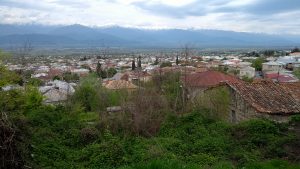
Telavi is the capital of the region known as Kakheti – far eastern Georgia where the craft of wine-making was invented some 8000 years ago.
When we got to our guest room in Telavi, it was 3pm – way past breakfast and lunch – and we were quite famished. Our hosts were Zaal & Neli, who lived in a very nice house with several guest rooms on the edge of town. Zaal proceeded to pull out a bottle of his homemade white wine, as well as bread and homemade cheese. I’ve tasted a lot of homemade wine, but this was a standout. Top-notch! And the snacks were perfect!
Zaal, a retired architect, explained that he had a farm in the Alzani River valley nearby where he grew grapes and strawberries, as well as keeping a milk cow and assorted other creatures. The grapes were made into wine using the traditional qvevri method at the community winery. He inquired about our interests and whether there was anything we wanted to see in the area.
After our snacks, we went into town to walkabout a bit, and see what there was to see. An old fort, a statue of Erekle II, magnificent views of the Greater Caucasus Mountain range – we actually never did find the old part of town … got sidetracked by other things. We had walked through the fort and then got some refreshment at a cafe nearby. While in the cafe, a woman approached us, said she had seen us in the fort, and wondered what we were doing in Telavi? She had been a Russian language teacher for many years, and enjoyed practicing English. She also said that during the Soviet era, she would never have spoken to a tourist – due to the political grief she would encounter. She talked about the Georgian Folk Music shows that she organized, then left us with her phone number should we need any help with anything during our visit to Telavi. And then it was time for supper. Here’s a little primer on Georgian cuisine. We ordered a main course and what we thought was a few appetizer dumplings (Khinkali) that turned out to be a meal in themselves… Oh — and of course another glass of that local wine. As we say in Minnesota after such a meal — uffda!
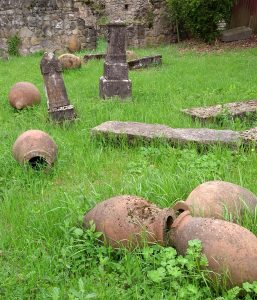
The next morning, we went to the kitchen for breakfast and found that Zaal had arranged a tour for us. An off-duty policeman (who spoke no English, but was an excellent and non-scary driver) was to drive us around all day to various points of historical interest, and 4 wineries where we would learn about the traditional way of making Georgian wine. He took us to:
Ikalto Monastery – founded in the 6th century, current church built about 200 years later. Tombstones erupting from the churchyard everywhere, and an 8th century winepress in remarkably good shape. Persian invaders burned the complex in 1616 and it never fully recovered.
Alaverdi Monastery – Impressive Georgian Eastern Orthodox cathedral about 1000 years old. Remains an active monastery where the monks tend vineyards and operate a winery.
Twins Cellar – Winery/Guest House/Museum. The museum looked a little hokey, but was actually quite informative. We also ordered a tasting. For the two of us, they brought a generous plate of bread and cheese, along with 3 carafes of different wine varieties which looked to be about 250ml each. Way too much to drink at 1130 in the morning, so we left most of it behind.
Gremi – We visited what is left of Gremi. On the old Silk Road, it used to be capital of the Kingdom of Kakheti, until it was utterly destroyed during the Persian invasion of 1616. During this invasion, tens of thousands of Kakhetians were killed, and hundreds of thousands deported to Persia as slaves. The capital was subsequently moved to Telavi.
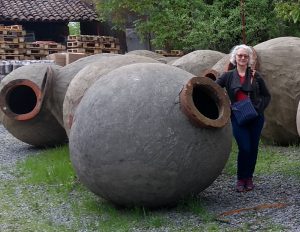
Nekresi Monastery – Old monastery complex high on a hill with spectacular views across the Alazani River valley. Originally built in the 3rd century AD, it’s been recently restored and has an excellent example of a qvevri style winery from way back in the day.
Kindzmaraul Winery – Winery tour and tasting. This place produces both Qvevri style wines. I liked the wine here better than at Twins Cellars.
Khareba Winery – This winery has 8km of wine storage tunnels, and produces both Qvevri and European style wines. We had an opportunity to taste the “same” wine comparing the Qvevri style vs European. My palate favors the European style. We brought a bottle back to Barcelona with us, and savored it while writing this blog post.
Tsinandali Winery – Regretfully, we did not visit this place. We were kind of wore out from the 3 previous wineries, and needed a break!
When we got back to our guest house in Telavi, Zaal gave us another jug of his homemade wine – but by that time, we just wanted some food and only managed a few sips to be sociable.
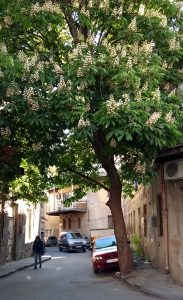
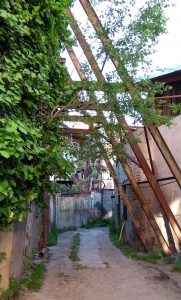
Next morning, Zaal had arranged for the brother of yesterday’s guide to give us a taxi ride back to Tbilisi — much less dramatic than our ride to Telavi, and for that we were thankful! We had booked a room in the old part of Tbilisi. The taxi driver had quite a time trying to find the street – but finally we made it. The streets were narrow and winding, and. although the hotel where we stayed looked quite sound, a lot of the structures in the area seemed quite ramshackle.
Unlike Telavi, it seemed packed cheek to jowl with tourists and souvenir shops. For lunch we had khachapuri, a cheese filled bread that is an integral part of the Georgian identity. So much so, that the khachapuri index was developed by Georgian economists to measure inflation — by comparing the cost of making khachapuri in different cities. We visited a public sulphur bath (numerous sulphur hot springs in the area), had a pleasant walk through the city, and enjoyed some down time.
It’s Monday morning, and we need to get to Batumi tonight, so we can board a plane on Tuesday for the return flight to Barcelona. The central rail station seemed like a probable location for finding a marshrutka to Batumi, so that’s where we went. As soon as we showed up with our luggage, several guys rushed up offering taxi service to wherever we wished to go. When we said Batumi, they started bargaining … got them down from $125 to about $75 for the 5 hour drive – but we wanted to find out what the marshrutka service was like and declined the offer. Once inside the train terminal, we started looking for a storage locker to safeguard our luggage for a few hours while we looked for a ride – an elderly gentleman spent considerable time with us trying to figure out what we wanted, and finally pointed us in the right direction to the luggage lockers. (Did I ever mention how helpful, courteous, and hospitable the Georgians seem to be?)

Near the train station is the city bazaar, and that’s where the marshrutkas were lined up. It was quite easy to find one, and as soon as we expressed interest, the driver ran over to the train station with us and retrieved our bags from the luggage lockers. The price was about $12 each for what turned out to be a 6-1/2 hour drive from Tbilisi, through Kutaisi, then on to Batumi. The 2 lane highway between Tbilisi and Batumi seemed to be in fairly good repair. There were more country homes along this road than what we saw on the way to Telavi. I’m sure we saw hundreds of these places and one thing that struck me — virtually all of them have food gardens and orchards. A dozen or more nut trees, often just as many fruit trees, and produce as well. I suspect that a good many of them have a tandoor oven out back as well, but we didn’t see a lot of them as we whizzed along the highway.
Batumi is the 2nd city of Georgia – after Tbilisi. Its economy revolves around tourism and gambling, but it also is an important seaport and has significant shipbuilding and food processing industries.
It was getting close to dark when we arrived in Batumi. After checking in to our hotel we walked to the waterfront to get a picture of the Ali & Nino statue, and prepared to close the chapter on this voyage to the Caucasus. Teresa mentioned Ali and Nino in her Azerbaijan post. If you missed that, it is a novel published in the 1930s about a Georgian woman and an Azerbaijani man who lived during the tumultuous years of 1915-1920 when there was a great deal of political turmoil in the region. Imagine fighting with the Ottoman Empire during WWI, coming through that alive, and then being pummeled by blowback affects from the Russian Revolution. I liked the book better than the movie – but the movie (youtube link) was filmed on location in Azerbaijan and includes some gorgeous scenery. Either version also sheds some significant context on the interesting geo-political situation of the mid-Caucasus. I found them both quite worthwhile, especially so if you ever decide to visit this corner of the world.


I especially enjoy reading how people interact with you there. What fun!